Concentration Camps
The concentration camp was the final step in the Nazis ideological march to create a Europe without Jews. The written, historical narrative began with Adolph Hitler's voice in Mein Kampf ( My Struggle--published 1925) written during his nine month imprisonment following his failure to overthrow ( beer hall putsch 1923) the Bavarian government. Although he expressed the belief that humanity would best be served if the weak and infirm were eliminated from German society, his broader theme was the preservation of the "purity" of the Aryan character and culture of Germans.
"All the human culture, all the results of art, science, and technology that we see before us today, are almost exclusively the creative product of the Aryan."
It was only a short step in his manifesto to single out Jews and Slavs as inferiors and the former, in particular, as conspirators bent on tainting the racial purity of Germans. He said that it was the will of the Lord "to defend myself against the Jew." Their mere presence was perceived as a threat to the Aryans. Hitler's immediate goal was their elimination from German society. That was an achievable goal considering there were only 500,000 Jews living in Germany. The calculus changed dramatically when confronted with 9.5 million Jews mainly in nations that the Wehrmacht would occupy after September 1, 1939.
Thus the immediate concern was a solution to rid Germany of 1/2 million of its citizens. The rational solution was voluntary or involuntary deportation. There would be a brief hiatus to implementing the Nuremberg anti Jewish laws (1935) in the following year. Hitler desired to portray Germany's benign face to the international community as he hosted the Olympics. When his National Socialist government attained power in 1933, the Nazis promoted this Jewish policy by confiscation, outright looting, murder and reached a crescendo on the streets of Germany and the avenues of annexed Austria (1938) in an action now known as Kristallnacht (1938). Hitler's rationale was that conflicts were inevitable and his philosophy emphasized the survival of the fittest. This was completely compatible with his notion of Aryan superiority. The American consul in Leipzig was not fooled by Nazi attempts to describe the Kristallnacht pogrom as a popular uprising and immediately characterized it as well organized.
Utilizing concentration camps to imprison dissidents, political activists, leaders of opposition movements was not a new phenomena. This form of confinement had been used in South Africa by the British and Germans at the turn of the 20th century and by the Turks in the Armenian Genocide. After one year in power, the Nazis opened their original prototypical facility at Dachau (1933). The camp was near Munich coincidentally the early seat of Hitler's power. This camp imprisoned political activists (particularly Communists/Bolsheiks) religious dissidents of all stripes, criminals, homosexuals and added Jews to that list. Hitler having been granted dictatorial power, there was no due process or appeal. There were several distinctions between the early years of the 8 prewar camps and the war time years. For some few prisoners, sentences were commuted and were released upon the condition that they were sworn to secrecy not to describe camp conditions. The other differences will be apparent as the history unfolds.
Your editor has taken the liberty to describe his experience at Dachau which he visited several months after its liberation (April 1945). "Word had reached us about camp atrocities but the news made little impression in the ranks. Nevertheless, some of us were curious to view a camp. My driver and I arrived on a sunny spring day in an open jeep and parked outside the walls next to a six foot wide grass median that ran the length of the wall to the gate--about 50 feet. He had been here at the liberation. He would answer no questions. 'See for yourself', he said.The camp was closed. There was no sign of life although the gates were open. I jumped out of the jeep onto the grass and immediately began to sink and scrape the grass and mud from my boots. Muttered the usual G.I. curse and my friend raised his hand to cut me off. 'Your walking on a mass grave.' The shock and horror experienced by this 17 year old was inestimable, and I had not yet penetrated the concentration camp." The reader will share this experience as this narrative continues.
Dachau www.petermillerphotography.com
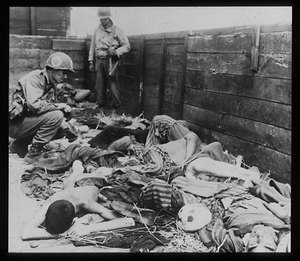
During the first two years after Germany invaded Poland, the initial round up of Jews was under a general policy of hold until expelled. That did not prevent random mass murder, beatings and organized looting and confiscations. In these early years, the Nazis were experimenting with eliminating "racially inferior" elements of society. Under their euthanasia program (T4), they gassed the old and infirm, German citizens.
The Nazis found an inexhaustible supply of enemies before the first shots were fired in Poland. The bloodless annexations of Austria (1935) and the Sudetenland (1938) were German victories embraced by the public. It had the effect of deflecting critical opinion away from the intrusiveness of the Nazis machine that continued to imprison an ever growing list of dissidents defined by party ideology. Dachau was only a starting point. Several more camps were brought on line before September 1939 that were administrative models for the almost 1200 camps and sub camps that would dot the landscape of the Greater German nation and the occupied countries (General Government): Buchenwald (near Weimar---seat of the deposed Republic--1937), Ravensbrück,( a women's facility south east of Berlin-- 1939), Mauthausen (a mix of Austrian prisoners in all categories-- 1938), Oranienberg (one of the smallest--1933) replaced by Sachsenhausen (20 miles north of Berlin--1936), Flossenbürg (in Bavaria near Czech border--1938), Neuengamme (near Hamburg--1938).
Oranienberg-- German Federal Archive
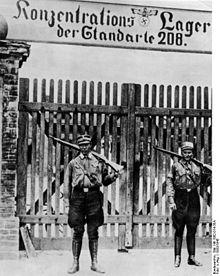 |
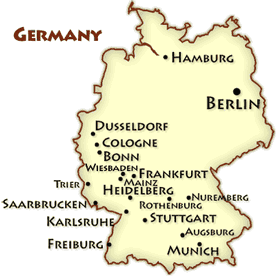 |
Essentially there were three types of concentration camps and many were a combination of all or some: Labor, transit, extermination. Those held for transit were temporary prisoners and could be scheduled for forced labor or death at another site. The Westerbork Camp (1940-1945) in the Netherlands was exclusively a transit site. The Fort VII camp in Poland, late 1939, combined detention and transit. The Gross-Rosen camp in Poland, began operation in 1940, was solely a labor camp responsible for 40,000 deaths. Theresienstadt was in a separate mold. It was both a transit camp and a faux model ghetto--good enough to fool the inspection of the International Red Cross on a given day.
Jews in the Netherlands lived under the harshest conditions prior to their wholesale round up. The restrictions ranged from limitations on food rations to the insignificant rule prohibiting Jews from motion picture theaters.This was particularly painful to a young Amsterdam girl who dreamed of becoming an actress.
The Westerbork camp was similar to many Nazi transit depots that were starting points for millions of prisoners. It's most famous prisoner, Anne Frank, arrived there at age 15 (August 1944) with her sister, Margot, mother and father. Anne and her family had been hidden by a Dutch family since July 1942. Two years later they were arrested after their hiding place was disclosed by a neighbor. During the period when she was hidden, she maintained a diary that was later published after the war as "The Diary of a Young Girl" read by millions.
The family arrived at Auschwitz in September 1944 where
the family escaped "selection" for the gas chamber. Anne missed that
path by three months. 15 years old was the cut off date. Her father was
separated and the only survivor of the family. In October 1944, Anne and
her sister, Margot, and mother was transferred to Bergen - Belsen,
a labor camp in Germany. Her imposed travels as a prisoner had carried
her from the Netherlands east to Auschwitz in Poland and west to a
German concentration camp where her mother died after her 2 daughters
died of malnutrition and disease. The typhus epidemic was Anne's
immediate cause of death in March 1945. About one month later the camp
was liberated by British forces. Anne and her sister were buried in Bergen-Belsen.
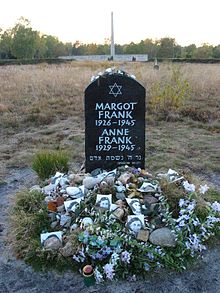
There were several characteristics of these forced labor camps that were identical. Primarily these were used for forced labor. Flossenbürg and Mauthausen were adjacent to stone quarries. Some of the other camps employed "make labor" details that had no utilitarian value. Later the camps would contribute labor to the industrial effort to support the war. Each camp was divided into two departments; Administrative and Security (guards). the entire system was under the authority of the SS and Heinrich Himmler was at the top of the hierarchy. Authority to imprison was solely in the hands of the security police (SiPo) and divided by their criminal police and Gestapo with sole authority to incarcerate with the euphemistic description , "preventive detention" not subject to judicial revue.
The purpose of the early camp at Oranienburg was to "concentrate" enemies and had no other purpose. However, the other concentration camps (lager) intended the prisoners to work for the benefit of the Reich---work until death. The estmated deaths in most of these camps ranges from 30,000 to 50,000. Although Sachsenhausen deaths were closer to 100,000.
Some of thes labor camps also acquired small gas chambers: Sachsenhausen, Neuengamme, Mauthausen, Stutthof, Gross-Rosen and Ravensbrück. They were obviously invested in the Wannsee policy.
Then there was Janowska--1941-1943--, near Lvov Ghetto,
that was all of the above. A ghetto, labor camp, transit camp and
another Nazi arm for extermination. In another Ukrainian area, Belarus,
the camp at Maly Trostenet liquidated 206,000 from 1941 to 1944.
Boundary lines in this eastern European area were constantly exploited
by neighbors. Poland, Ukraine, Romania, Soviet Union were incessant
contestants. In areas that were under the authority of an ally (Romania, Hungary), the risk of death was diminished to the extent that public opinion railed against extermination.
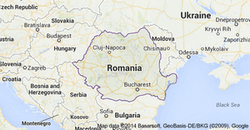 |
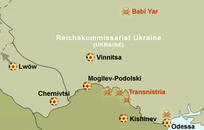 |
Extermination as an official policy made its entry southward that were not part of the Operation Reinhard plan in the Balkans. These areas seemed to have a life of its own. They were extermination camps before the "final solution" was a fixed policy, In Croatia, the Jasenovic camp operated for four years and exterminated a mixed population of Serbs and Jews(1941-1945). The German policy in its occupation of Serbia established (1941-1944) the Sajmiste camp that eliminated 100,000 prisoners. However, Serbian guerrillas were an effective resistance movement that forced German forces to expend manpower in that country.
1940 signaled a change with the establishment of Auschwitz and its later adjunct, Birkenau. This was a dual purpose concentration camp utilizing it for forced labor and extermination. Over one million would die there. The attack on the Soviet Union (June 1941-Operation Barbarossa) was a total course correction that dovetailed with the agreement on a "final solution' of the Jewish question and Aktion Reinhard earlier in the year.
Operating under the authority of Reich Minister Alfred Rosenberg for the
eastern occupied territories, the SS organized mobile death squads
(Einsatzgruppen) to follow the Wehrmacht blitzkrieg into Soviet
territory with orders to round up Jews and gypsies and liquidate them.
They used vans equipped to pump carbon monoxide gas into the rear
compartment filled with prisoners. The apex of their activity, with the
aid and complicity of Ukrainian and Lithuanian volunteers, who also worked in the
concentration camps--mainly as guards (Hiwis = auxilliaries), was their mass murder of
33,000 Jews (and some, few Roma) in the Babi Yar forest located near Kiev.
There has been no estimate of the amount ammunition utilized in this 2 day killing spree. Overtime
these woods would witness the burial of well over 100,000 Jews added to
this massacre , were the millions of Soviet prisoners of war--on the list of the racially inferior-- that were
summarily dispatched, many in this forest.1,000,000 Jewish citizens of the Soviet Union would perish.
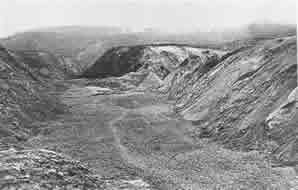 Courtesy Berdichev Revival |
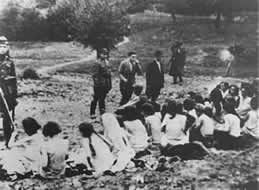 Waiting to die. |
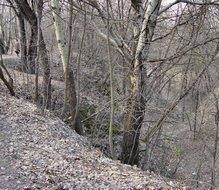
Photo Mark Voorendt
The ever efficient Germans, concluded that mass murder was too public and inefficient. This led to the experimental trial run by the poison gassing of Soviet prisoners of war at Auschwitz while it still was a small facility. Any international norms to the contrary were disregarded.
Operation Reinhard Camps
(Aktion Reinhard)
The Wannsee Conference (January 1942) broke with prior methodology designed to "encourage" Jews to migrate. It was too slow and overwhelmed by numbers in the occupied territories. Implementation was the portfolio of Aktion Reinhard. Reichsführer Heinrich Himmler issued an oral order to SS Police Chief Odilo Globocnik to begin building camps specifically designed for exterminating Jews. Active players included SS with T4 experience in liquidating the elderly and infirm.Three Polish locations, each near forested, non populated areas were chosen. Belzec was first, March 1942, followed by Sobibor in May 1942, and Treblinka in July 1942. Their score card: Belzec at least 600,000 dead, Sobibor murdered 200,000 and Treblinka almost 900,000. At least one pre- Aktion Reinhard camp would eclipse these numbers.
The design for each had many commonalities. Each camp was located along a branch line of the Polish Railway System. The unfortunate victims debarked in a railway station hung with friendly signs.Some would point to the direction of the delousing showers. All sorts of deceptions were utilized to avoid mass hysteria. in fact, the path that they trod led directly to a disrobing building and thence to a gas chamber where the room was packed with barely any breathing room. A steel door was locked, poison gas generated by Soviet tank engines was pumped into the chamber and in minutes all were dead. Their bodies, at first were unceremoniously dumped by Jewish sonderkommandos into mass graves. Later cremation ovens were added.
The camp population was low as almost all arrivees were liquidated on their first day. Camp security did not require electrified barbed wire. The inhabitants were the few Jewish attendants, SS personnel, collaborating Ukrainian guards trained in the Trawniki concentration camp in Poland's Lublin district. Guards controlled the barracks and manned raised towers about the perimeter.
The Polish camps at Chelmno, Majdanek and Auschwitz, pre Aktion Reinhard, would link to its chain of extermination camps. Chelmno was established in December 1941 as a testing ground for mass liquidation of the Lodz ghetto by gas. Majdanek, in the Lublin area, a proponent of Zyklon B gas, murdered over 75,000 between 1941 and 1944 and yet maintained a labor camp as well. In the last action under Aktion Reinhard, "Operation Harvest Festival" was the closing curtain in elimination of Jews in the eastern occupied regions. Majdanek's participation was the extermination of 18,000 Jews on November 3, 1943 with the SS manning the machine guns eliminating the Jewish population in the Lublin area.
Transnistria, a former region under Romanian sovereignty, was reoccupied by them with blessing of their Nazi ally as the Soviets withdrew from the Ukraine. Two concentration camps were organized. They defy description. We know that a handful of Jews survived out of a prisoner population of several hundred thousand.
Auschwitz-Birkenau
Auschwitz began as a labor camp in 1940 and extended its services to mass murder with the addition of Birkenau as well as 40 odd more sub camps. Auschwitz utilized arsenic based Zyklon B gas and can claim the infamous distinction of eliminating more than 1,000,000 Jews.They could kill 6.000per day and received daily trainloads from east and west. The trains carried prisoners from ghettos, other transit camps as far away as Yugoslavia and Greece. One shipment from the "model" ghetto at Thereienstadt carried 5,000 Czech Jews. They were housed in a "family camp" until gassed.
The benign looking entrance to Birkenau welcomed the unsuspecting arrivals to immediate death. Those temporarily spared in the "selection" process were sent to the labor section. Selection was made on a ramp on the side of the tracks.They would ultimately perish mixing their ashes with the thousands who had gone before them on the floor of a crematorium. The lucky few selected for forced labor were first marched to a room where their heads were shaved and issued striped uniforms. Those selected for assorting property of the victims in storerooms known as "Canada" were repaid by stealing trade objects for food and other necessities. They also had the responsibility for extracting gold fillings from the mouths of the dead. Some selected on the ramp by Dr. Josef Mengele were subjected to medical experimentation that broke every moral code of medicine.
Role call was 5 A.M. and again in the evening where they were forced to stand for hours in all types of inclement weather in flimsy shirts. Those that fell were shot. They were surrounded by 12 foot high electrically charged fences the favored place for suicides. SS guards carried rifles and manned machine gun posts placed in series as far away from the fence as two thirds of a mile.
Jewish Virtual Library
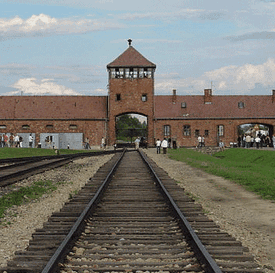
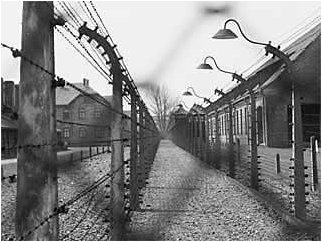 |
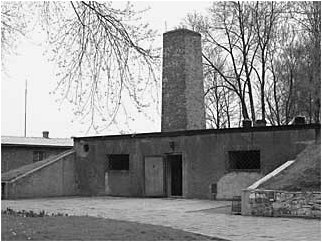 |
A survivor with a number tattoo on the left arm was a prisoner in Auschwitz. The only concentration camp to use this registration system. Much had to do with the size and growth of the city sized camp over 18 square miles with over 40 satellite locations. Initially, the camp began with brick barracks, a medical ward, workshops and 30,000 prisoners intended for forced labor and eventual extermination by death, disease, malnutrition or the use of a small gas chamber and crematorium. In March 1941, Himmler ordered expansion. Birkenau was built by Soviet prisoners and operational by 1943. The "upgrade" included a huge number of buildings, four underground gas chambers and crematoria that could gas 2000 at a time. Elevators were available to move corpses to crematoria above ground. During the construction phase, nearby farm houses were used to gas victims. When the crematoria were overloaded, the bodies of the victims were burned by the Sonderkommando in open pits.
The SS Camp Commandant, Rdolph Höss, described the last momemts of life in the gas chamber:
"It took about 3 to 15 minutes to kill the people in the gas chamber depending on climatic conditions. We knew when the people were dead because they stopped screaming. We usually waited about a half hour before we opened the door and removed the bodies." (U.S.Government, Nazi Conspiracy and Aggression, Washington D.C.: U.S. Government Printing Office 1946, p.6:788.
The forced labor section was an industrial city. I.G. Farben (chemical giant) maintained a synthetic rubber plant camp known as Buna-Monowitz. Workers were worked until they dropped and were replaced. Security was tight but a few prisoners were able to escape.
In August 1944, the main camp housed 105,000 and the satellites another 50,000. The supply was constant. That was the time that 4 escapees with the help of the camp underground navigated through the lines and reached friendly forces and were directed to a Jewish rescue organization. They carried maps to document locations of Nazi assets and information about the atrocities. They begged the allies to bomb the Auschwitz factories and railroad line.. Their plea was turned down by the U.S. War Department. The excuse was that the raid would require fighter escort needed elsewhere although it was in easy striking distance from bases in Italy. Presiden Roosevelt created a War Refugee Board for the explicit reason to bomb Auschwitz. The department stonewalled him. Appeals to Churchill got the same response about fighters needed elsewhere.The fact is that in July through November 1944 the prisoners looked up and would see Allied bombers directly overhead on the way to bomb nearby oil facilities and an industrial zone five miles away.
In October 1944, at morning roll call there was an unusual amount of German troops. When the SS demanded that the chief Sonderkommando deliver the names of 300 hundred men they all knew that the strict rotation was in order to kill these men. There was no such thing as job security. They had already planned a revolt and obtained a small amount of explosives smuggled to them by two girls working in the nearby Union explosives factory. When they refused to deliver the names they understood the result. One Jew, Chaim Neuhof, stepped forward and bludgeoned the SS officer with a hammer and he fell. The prisoners then ran into an empty barrack and set fire to mattresses. The flames spread to the roof of nearby Crematorium IV. They attempted escape through the wire they cut and most were machine gunned and died instantly. The fire was seen by the Sonderkommando of crematorium II and they rushed several guards and killed three corporals. They had no arms to defend themselves and they soon were shot. Subsequently, the two girls were found and hung. The men knew that their acts were suicidal but they considered suicide as an act of resistance.
In early January 1945, Soviet troops were in days from the camp. Germans were frantically attempting to move the prisoners toward Germany and other camps where forced labor was still indispensable. They marched over 50,000 through frigid weather hundreds of kilometers westward. Those that fell, if not dead from the cold or because of starvation, were shot. As many as 10,000 perished. The survivors were jammed into open freight cars and transported into camps in the north. Liberation found about 7.000 prisoners in the camp in terrible physical condition. This abandonment of the many camps in the line of Allied advances were referred to by the SS as evacuations.
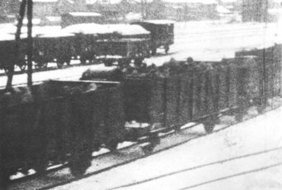 |
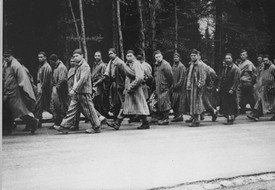 |
Auschwitz Evacuation Fitz Bauer institute Dachau Death March U.S. Holocaust Museum
Estimated Jewish Deaths in Europe
Jewish Population Deaths Jewish Population Deaths
|
Austria 185,000 50,000 Belgium 65,700 28,900 Bohemia/Moravia 118,310 78,150 Bulgaria 50,000 0 Denmark 7,800 60 Estonia 4,500 2,000 Finland 2,000 7 France 350,000 77,320 Germany 566,000 141,500 Greece 77,380 67,000 Hungary 825,000 569,000 |
Italy 44,500 7,680 Latvia 91,500 71,500 Lithuania 168,000 143,000 Luxembourg 3,500 1,950 Netherlands 140,000 100,000 Norway 1,700 762 Poland 3,300,000 3,000,000 Romania 609,000 287,000 Slovakia 88,958 71,000 Soviet Union 3,020,000 1,100,000 Yugoslavia 78,000 63,500 |
9,796,840 5,869,129
______________________________________________________________
References and Sources:
Blatman, Daniel, translated by Chaya Golai.The Death Marches Belknap Press of Harvard University Pres Cambridge, Mass 201
Grolier Educational, Holocaust Genocide Studies, Charles E. Smith Bools, Inc. Danbury, CT 1997.
Jewish Gen Inc.Kehila Links-Vitebsk
Marrus, Michael R. The Holocaust in History. University Press of New England, Hanover and London 1987.
The Holocaust Encyclopedia. Walter Laquer, Editor. Yale University Press, New Haven 2001.
The Yad Vashem Encyclopedia of the
Ghettos During the Holocaust, Guy Miron Ed, Schlomit Shulhani, Yad
Vashem, The Holocaust Martyrs and Heroes Remembrance Authority,
Jersalem, Israel.
Your first paragraph ...
American Wars > Holocaust Timeline > Concentration Camps